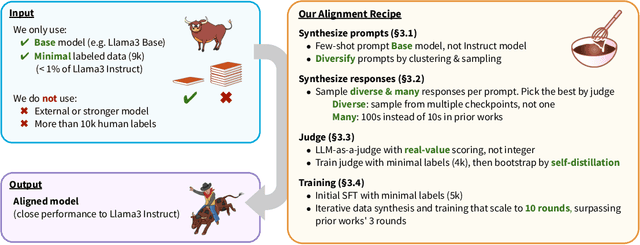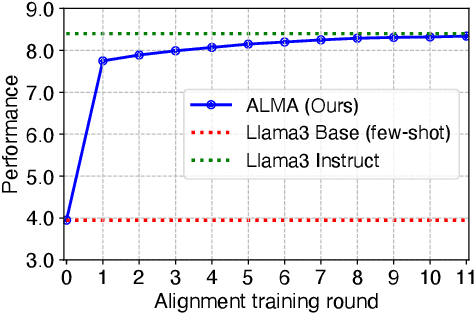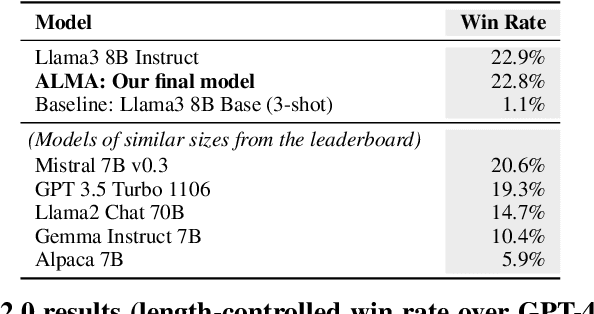Michihiro Yasunaga
Shammie
reWordBench: Benchmarking and Improving the Robustness of Reward Models with Transformed Inputs
Mar 14, 2025Abstract:Reward models have become a staple in modern NLP, serving as not only a scalable text evaluator, but also an indispensable component in many alignment recipes and inference-time algorithms. However, while recent reward models increase performance on standard benchmarks, this may partly be due to overfitting effects, which would confound an understanding of their true capability. In this work, we scrutinize the robustness of reward models and the extent of such overfitting. We build **reWordBench**, which systematically transforms reward model inputs in meaning- or ranking-preserving ways. We show that state-of-the-art reward models suffer from substantial performance degradation even with minor input transformations, sometimes dropping to significantly below-random accuracy, suggesting brittleness. To improve reward model robustness, we propose to explicitly train them to assign similar scores to paraphrases, and find that this approach also improves robustness to other distinct kinds of transformations. For example, our robust reward model reduces such degradation by roughly half for the Chat Hard subset in RewardBench. Furthermore, when used in alignment, our robust reward models demonstrate better utility and lead to higher-quality outputs, winning in up to 59% of instances against a standardly trained RM.
Multimodal RewardBench: Holistic Evaluation of Reward Models for Vision Language Models
Feb 20, 2025Abstract:Reward models play an essential role in training vision-language models (VLMs) by assessing output quality to enable aligning with human preferences. Despite their importance, the research community lacks comprehensive open benchmarks for evaluating multimodal reward models in VLMs. To address this gap, we introduce Multimodal RewardBench, an expert-annotated benchmark covering six domains: general correctness, preference, knowledge, reasoning, safety, and visual question-answering. Our dataset comprises 5,211 annotated (prompt, chosen response, rejected response) triplets collected from various VLMs. In evaluating a range of VLM judges, we find that even the top-performing models, Gemini 1.5 Pro and Claude 3.5 Sonnet, achieve only 72% overall accuracy. Notably, most models struggle in the reasoning and safety domains. These findings suggest that Multimodal RewardBench offers a challenging testbed for advancing reward model development across multiple domains. We release the benchmark at https://github.com/facebookresearch/multimodal_rewardbench.
CAT: Content-Adaptive Image Tokenization
Jan 06, 2025Abstract:Most existing image tokenizers encode images into a fixed number of tokens or patches, overlooking the inherent variability in image complexity. To address this, we introduce Content-Adaptive Tokenizer (CAT), which dynamically adjusts representation capacity based on the image content and encodes simpler images into fewer tokens. We design a caption-based evaluation system that leverages large language models (LLMs) to predict content complexity and determine the optimal compression ratio for a given image, taking into account factors critical to human perception. Trained on images with diverse compression ratios, CAT demonstrates robust performance in image reconstruction. We also utilize its variable-length latent representations to train Diffusion Transformers (DiTs) for ImageNet generation. By optimizing token allocation, CAT improves the FID score over fixed-ratio baselines trained with the same flops and boosts the inference throughput by 18.5%.
ALMA: Alignment with Minimal Annotation
Dec 05, 2024



Abstract:Recent approaches to large language model (LLM) alignment typically require millions of human annotations or rely on external aligned models for synthetic data generation. This paper introduces ALMA: Alignment with Minimal Annotation, demonstrating that effective alignment can be achieved using only 9,000 labeled examples -- less than 1% of conventional approaches. ALMA generates large amounts of high-quality synthetic alignment data through new techniques: diverse prompt synthesis via few-shot learning, diverse response generation with multiple model checkpoints, and judge (reward model) enhancement through score aggregation and self-distillation. Using only a pretrained Llama3 base model, 5,000 SFT examples, and 4,000 judge annotations, ALMA achieves performance close to Llama3-Instruct across diverse alignment benchmarks (e.g., 0.1% difference on AlpacaEval 2.0 score). These results are achieved with a multi-round, self-bootstrapped data synthesis and training recipe that continues to improve for 10 rounds, surpassing the typical 3-round ceiling of previous methods. These results suggest that base models already possess sufficient knowledge for effective alignment, and that synthetic data generation methods can expose it.
Image2Struct: Benchmarking Structure Extraction for Vision-Language Models
Oct 29, 2024



Abstract:We introduce Image2Struct, a benchmark to evaluate vision-language models (VLMs) on extracting structure from images. Our benchmark 1) captures real-world use cases, 2) is fully automatic and does not require human judgment, and 3) is based on a renewable stream of fresh data. In Image2Struct, VLMs are prompted to generate the underlying structure (e.g., LaTeX code or HTML) from an input image (e.g., webpage screenshot). The structure is then rendered to produce an output image (e.g., rendered webpage), which is compared against the input image to produce a similarity score. This round-trip evaluation allows us to quantitatively evaluate VLMs on tasks with multiple valid structures. We create a pipeline that downloads fresh data from active online communities upon execution and evaluates the VLMs without human intervention. We introduce three domains (Webpages, LaTeX, and Musical Scores) and use five image metrics (pixel similarity, cosine similarity between the Inception vectors, learned perceptual image patch similarity, structural similarity index measure, and earth mover similarity) that allow efficient and automatic comparison between pairs of images. We evaluate Image2Struct on 14 prominent VLMs and find that scores vary widely, indicating that Image2Struct can differentiate between the performances of different VLMs. Additionally, the best score varies considerably across domains (e.g., 0.402 on sheet music vs. 0.830 on LaTeX equations), indicating that Image2Struct contains tasks of varying difficulty. For transparency, we release the full results at https://crfm.stanford.edu/helm/image2struct/v1.0.1/.
VHELM: A Holistic Evaluation of Vision Language Models
Oct 09, 2024



Abstract:Current benchmarks for assessing vision-language models (VLMs) often focus on their perception or problem-solving capabilities and neglect other critical aspects such as fairness, multilinguality, or toxicity. Furthermore, they differ in their evaluation procedures and the scope of the evaluation, making it difficult to compare models. To address these issues, we extend the HELM framework to VLMs to present the Holistic Evaluation of Vision Language Models (VHELM). VHELM aggregates various datasets to cover one or more of the 9 aspects: visual perception, knowledge, reasoning, bias, fairness, multilinguality, robustness, toxicity, and safety. In doing so, we produce a comprehensive, multi-dimensional view of the capabilities of the VLMs across these important factors. In addition, we standardize the standard inference parameters, methods of prompting, and evaluation metrics to enable fair comparisons across models. Our framework is designed to be lightweight and automatic so that evaluation runs are cheap and fast. Our initial run evaluates 22 VLMs on 21 existing datasets to provide a holistic snapshot of the models. We uncover new key findings, such as the fact that efficiency-focused models (e.g., Claude 3 Haiku or Gemini 1.5 Flash) perform significantly worse than their full models (e.g., Claude 3 Opus or Gemini 1.5 Pro) on the bias benchmark but not when evaluated on the other aspects. For transparency, we release the raw model generations and complete results on our website (https://crfm.stanford.edu/helm/vhelm/v2.0.1). VHELM is intended to be a living benchmark, and we hope to continue adding new datasets and models over time.
Language Models are Graph Learners
Oct 03, 2024



Abstract:Language Models (LMs) are increasingly challenging the dominance of domain-specific models, including Graph Neural Networks (GNNs) and Graph Transformers (GTs), in graph learning tasks. Following this trend, we propose a novel approach that empowers off-the-shelf LMs to achieve performance comparable to state-of-the-art GNNs on node classification tasks, without requiring any architectural modification. By preserving the LM's original architecture, our approach retains a key benefit of LM instruction tuning: the ability to jointly train on diverse datasets, fostering greater flexibility and efficiency. To achieve this, we introduce two key augmentation strategies: (1) Enriching LMs' input using topological and semantic retrieval methods, which provide richer contextual information, and (2) guiding the LMs' classification process through a lightweight GNN classifier that effectively prunes class candidates. Our experiments on real-world datasets show that backbone Flan-T5 models equipped with these augmentation strategies outperform state-of-the-art text-output node classifiers and are comparable to top-performing vector-output node classifiers. By bridging the gap between specialized task-specific node classifiers and general LMs, this work paves the way for more versatile and widely applicable graph learning models. We will open-source the code upon publication.
Transfusion: Predict the Next Token and Diffuse Images with One Multi-Modal Model
Aug 20, 2024



Abstract:We introduce Transfusion, a recipe for training a multi-modal model over discrete and continuous data. Transfusion combines the language modeling loss function (next token prediction) with diffusion to train a single transformer over mixed-modality sequences. We pretrain multiple Transfusion models up to 7B parameters from scratch on a mixture of text and image data, establishing scaling laws with respect to a variety of uni- and cross-modal benchmarks. Our experiments show that Transfusion scales significantly better than quantizing images and training a language model over discrete image tokens. By introducing modality-specific encoding and decoding layers, we can further improve the performance of Transfusion models, and even compress each image to just 16 patches. We further demonstrate that scaling our Transfusion recipe to 7B parameters and 2T multi-modal tokens produces a model that can generate images and text on a par with similar scale diffusion models and language models, reaping the benefits of both worlds.
AvaTaR: Optimizing LLM Agents for Tool-Assisted Knowledge Retrieval
Jun 18, 2024



Abstract:Large language model (LLM) agents have demonstrated impressive capability in utilizing external tools and knowledge to boost accuracy and reduce hallucinations. However, developing the prompting techniques that make LLM agents able to effectively use external tools and knowledge is a heuristic and laborious task. Here, we introduce AvaTaR, a novel and automatic framework that optimizes an LLM agent to effectively use the provided tools and improve its performance on a given task/domain. During optimization, we design a comparator module to iteratively provide insightful and holistic prompts to the LLM agent via reasoning between positive and negative examples sampled from training data. We demonstrate AvaTaR on four complex multimodal retrieval datasets featuring textual, visual, and relational information. We find AvaTaR consistently outperforms state-of-the-art approaches across all four challenging tasks and exhibits strong generalization ability when applied to novel cases, achieving an average relative improvement of 14% on the Hit@1 metric. Code and dataset are available at https://github.com/zou-group/avatar.
HippoRAG: Neurobiologically Inspired Long-Term Memory for Large Language Models
May 23, 2024Abstract:In order to thrive in hostile and ever-changing natural environments, mammalian brains evolved to store large amounts of knowledge about the world and continually integrate new information while avoiding catastrophic forgetting. Despite the impressive accomplishments, large language models (LLMs), even with retrieval-augmented generation (RAG), still struggle to efficiently and effectively integrate a large amount of new experiences after pre-training. In this work, we introduce HippoRAG, a novel retrieval framework inspired by the hippocampal indexing theory of human long-term memory to enable deeper and more efficient knowledge integration over new experiences. HippoRAG synergistically orchestrates LLMs, knowledge graphs, and the Personalized PageRank algorithm to mimic the different roles of neocortex and hippocampus in human memory. We compare HippoRAG with existing RAG methods on multi-hop question answering and show that our method outperforms the state-of-the-art methods remarkably, by up to 20%. Single-step retrieval with HippoRAG achieves comparable or better performance than iterative retrieval like IRCoT while being 10-30 times cheaper and 6-13 times faster, and integrating HippoRAG into IRCoT brings further substantial gains. Finally, we show that our method can tackle new types of scenarios that are out of reach of existing methods. Code and data are available at https://github.com/OSU-NLP-Group/HippoRAG.
 Add to Chrome
Add to Chrome Add to Firefox
Add to Firefox Add to Edge
Add to Edge